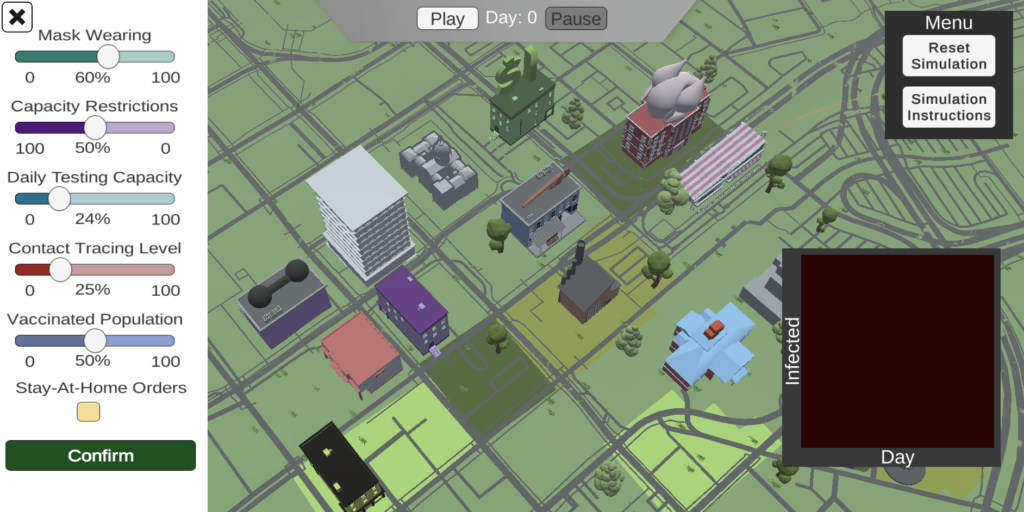Dense metro areas like New York City and Los Angeles were among the hardest hit in the early days of the COVID-19 pandemic. But it wasn’t long before the disease moved beyond urbanized regions and inundated America’s small towns.
To simulate how COVID-19 spreads through smaller communities and how interventions such as vaccinations and mask-wearing affect the spread of the virus, Johns Hopkins researchers have developed an interactive online platform called “Anytown, USA.”
Anytown, USA is an extension of the Delineo Disease Modeling Project at Johns Hopkins, a multidisciplinary endeavor that aims to create news tools for modeling the spread of pandemics.
Anton Dahbura, associate research scientist in the Department of Computer Science, said the idea for the simulator came from watching the pandemic evolve in his own hometown of Hagerstown, Maryland, and seeing how COVID-19 impacted such smaller towns and communities differently than it affected Washington, D.C. and Baltimore, despite being only an hour away.
“We recognized that the way COVID-19 spreads in small and rural towns is different than how it spreads in large cities, or college towns, or even resort towns. People thought, it’s not going to come here, but in reality, it’s just a matter of time before it spreads everywhere, similar to the flu,” said Dahbura, who is a member of the Malone Center for Engineering in Healthcare and co-director of the Johns Hopkins Institute of Assured Autonomy, as well as the executive director of the Johns Hopkins University Information Security Institute.
Dahbura is collaborating on the project with Kimia Ghobadi, an assistant professor in the Department of Civil and Systems Engineering and a member of the Malone Center.
The simulator models a fictional Midwestern town of about 6,000 inhabitants called Anytown, USA, whose residents commute to work, sweat it out at the gym, and frequent local staples like Bob’s Smokehouse and Ed’s Hardware. The simulation tracks about two months of movement and subsequent transmission, starting with a few COVID-19 infected people who go on to infect others—all depending on parameters such as the percentage of people who wear masks and are vaccinated or capacity restrictions on restaurants and bars.
Users can plug in various circumstances and see their expected effects on coronavirus spread. What might happen if the town has fewer vaccinated residents but more residents who wears masks, for example? In this virtual world, users can visualize how COVID-19 will impact a given city under different scenarios.
Anytown’s creators hope that the tool can support education and public health outreach efforts. For example, teachers can use it to show students how a pandemic can spread in real time, in their own community.
“By focusing on the end-user, our goal is to further bridge the gap between academia and the rest of the world when it comes to understanding models used to simulate and predict disease spread. Every community is different, and as the past year has shown, a one-size-fits-all approach doesn’t work,” said Mathias Insley, Anytown project manager and a fourth-year materials science and engineering major. “Anytown communicates the impact of certain interventions and public health policies in a user-friendly way. We hope that brings greater attention to the fact that we all have a part to play in stopping the spread of COVID.”
To create the simulation, the team incorporated the best-known disease models for COVID-19, including what we now know about the virus’s progression pattern. But to truly understand how diseases move, you must understand how people move, said Dahbura. His team leveraged mobility data provided by Gravy Analytics, SafeGraph, and XMode Social to create realistic population movements in Anytown. With the right data, Anytown can be modified to simulate the spread of variants like the Delta strain, or any other infectious respiratory illness that might emerge.
The project began in the spring of 2020 and involved a team of 30 Whiting School of Engineering undergraduate students, all of whom were eager to stay busy during the campus shutdown.
For Melody Lee, a fourth-year computer science major who was part of the sub-team that built the SimCity-esque interface for Anytown, the project felt like working in a real-industry startup.
“I found plenty of opportunities in the project to get more involved and take on more responsibilities over time. Now as a scrum master, I relay information among team members and help with technical issues, which mostly consist of debugging codes and researching ways to implement certain functionalities,” she said.
Anney Ye, a second-year computer science major, coded the features embedded in the simulation software. She said integrating all the software needed for Anytown to work proved to be a challenge, but her team prevailed. “Initially, we just couldn’t seem to get the simulator to work. It took lots of tireless communication, teamwork, and collective debugging efforts to finally overcome this and put a working build onto the website,” said Ye.
Dahbura noted that because there are several unknowns about COVID-19, developing any prediction model is not easy. And since the simulator is designed to be random, it demonstrates that the unpredictability of the infection process in a community can lead to very different results, even in similar circumstances.
“There are no certainties. Someone could come to a town infected and, by luck of the draw, nothing happens. Or just by bad luck they go to the wrong place, at the wrong time, and there’s a huge outbreak,” said Dahbura. “But the idea is to get people to visualize how this happens, how quickly things can change, and how interventions can make a huge difference. With the right combination of interventions, we can really fight back against this virus.”
This article originally appeared on the Hub >>
